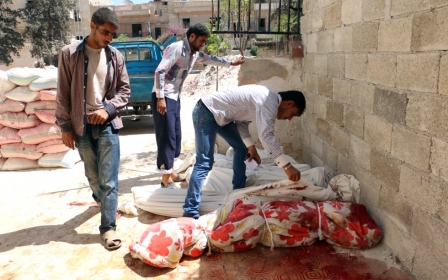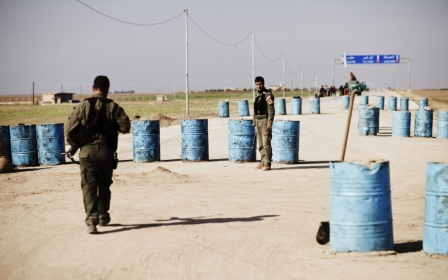In Syria's Aleppo, school is a basement under air raids

By Zein al-Rifai
ALEPPO, Syria - Back to school for children in the rebel-held part of Syria's northern city of Aleppo can mean having to cower in classes underground, sheltering from relentless government air raids.
At one school, children run from the sunlight into dimly lit corridors at the bottom of stairs leading to the basement.
Several dozen of them, boys and girls of different ages, squeeze onto benches behind 15 bare desks in one classroom.
The white paint is peeling from the walls in places, and there is none of the usual classroom paraphernalia.
The children have few notebooks and pens and pencils among them, but they still enthusiastically join in a singalong and pay attention as teacher Abdullah writes on the whiteboard.
"The children do their lessons underground in the basement because of the bombings," Abdullah says.
"On the floors above, the school is well-equipped, but the intensity of the bombing has forced us to move the children to the basement.
"It's very difficult for them, and we feel that they're under pressure when they go into the basement so we try to lift their spirits and entertain them so they get used to it," he adds.
Danger in the playground
"We hope, God willing, that soon it will be safe to return above ground."
In between classes, the children flood up the stairs for a brief break in the open air, despite the dangers posed by government air strikes on the rebel-held east of the city.
Syrian government planes and helicopters frequently overfly the area, firing rockets and dropping explosive-packed barrel bombs that kill and wound indiscriminately.
"We come up to play a bit and have some fun because we've been underground for a long time," says Jaafar, wearing a grey hooded top, as his classmates hop and twirl around him.
"But we can't stay for long because we're scared a plane might come and bomb us," he adds.
In the playground the children run around freely and two girls twirl in circles, clasping onto each other at the wrists.
Another little girl, in a red shirt and blue sandals, bounces a ball in the courtyard as a boy wearing a green backpack claps his hands and a girl in a headscarf jumps over a skipping rope.
Thousands of Syrian children have been killed in the conflict that began in March 2011, and many more have been displaced by the fighting between government forces and the rebels.
4,000 schools destroyed
Aleppo has been among the areas worst ravaged by the fighting, and in particular by the government's aerial campaign which has destroyed much of the country's one-time economic hub.
According to the Syrian Observatory for Human Rights, a Britain-based monitoring group, almost 3,000 people have been killed in government air bombardment this year.
Nearly 800 children were among the dead, the group said on Tuesday.
Schooling is now sporadic and haphazard, with little in the way of a formal curriculum and children of different ages crammed together in the same lessons.
Overall, some 4,000 Syrian schools have been destroyed, damaged or used to house the internally displaced in three years of warfare, leaving the educational system on the verge of ruin, said a report in May by the Damascus-based Syrian Centre for Policy Research in conjunction with the UN Development Programme and the UN Palestinian refugee agency.
Nationwide, the report said, just over half (51.8 percent) of school age children were not going to school but that figure reached 90 percent in Aleppo and Raqa provinces, and 68 percent in the Damascus provincial country.
Aleppo teacher Mona says much has changed since she began teaching before the uprising.
"We've been forced to take homes that aren't fit for living in and turn them into schools," she says.
"The students suffer, there's no space to play. The classes always face the fear of danger, the areas they are in are often targeted," she adds.
Children often miss classes, coming back weeks later and telling her their homes were hit in shelling or air strikes.
"They say 'I was in such-and-such area and it came under fire, my house was destroyed, or my brother was killed'."
"Students are the biggest victims in this revolution."
New MEE newsletter: Jerusalem Dispatch
Sign up to get the latest insights and analysis on Israel-Palestine, alongside Turkey Unpacked and other MEE newsletters
Middle East Eye delivers independent and unrivalled coverage and analysis of the Middle East, North Africa and beyond. To learn more about republishing this content and the associated fees, please fill out this form. More about MEE can be found here.




